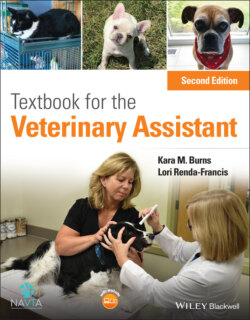Читать книгу Textbook for the Veterinary Assistant - Lori Renda-Francis - Страница 50
Restraint
ОглавлениеThe health‐care team should be aware of situations where a dog may not be handled safely and restraint equipment should be employed for the overall safety of the team and the patient. It is important to insure that all dogs have a collar and leash fitted during handling. The following list contains a variety of mechanical restraint devices that will be discussed in more detail.
Leash
Gauntlet
Muzzle
Catchpole
Voice
One of the most readily available and simple tools for restraining dogs is the leash. Leashes in the hospital setting are typically a nylon rope with a handle at one end and a slip loop (for quick size adjustments) on the opposite end (Figure 4.1). The leash should be held open above the dog’s head and readily available to place around the head or body when restraint is indicated. The slip loop allows for easy tightening or loosening when restraining or releasing the patient. It can be used cautiously on feline patients as well, although this use is not as common as with canine patients. All health‐care team members should keep a rope or leash available at all times.
To protect health‐care team members, heavy leather gloves known as gauntlets are often indicated. These are used to protect the hands and forearms when dealing with aggressive or fearful animals. Although gauntlets are made of thick leather, dogs, cats and birds have been known to bite or pinch through them. The thickness of the gloves typically allows the wearer to feel the bite or pinch before major injury occurs, thus enabling them to circumvent a potentially serious situation. Remember, the gauntlets may reduce the wearer’s overall sense of touch and strength. Therefore, the wearer must take care not to exert excessive pressure on patients during restraint procedures. A decreased sense of touch and strength coupled with the restrainer’s increased excitability and adrenaline can be a very dangerous mix.
Using a muzzle is another way to protect the health‐care team, the owner, and the dog if the patient is nervous or aggressive. There are a number of muzzles available and a recommendation of a type or brand should be given by the health‐care team to the owner. The muzzles most often used are a wire/Baskerville muzzle, a nylon/Mikki muzzle, or a gauze muzzle. In place of a commercially manufactured muzzle, health‐care team members can utilize a roll of gauze, a nylon sock, or even a piece of rope. However, the dog needs constant monitoring when it is muzzled to ensure there is no obstruction to the airway. Care must also be taken to ensure the muzzle can be removed efficiently and quickly. If the dog is thought to be likely to bite, its head should be safely restrained by a health‐care team member while the muzzle is removed. Muzzles should be used only short term because they prevent dogs from panting and could thus lead to overheating if left on for extended periods. The health‐care team should be especially prudent when using muzzles on brachycephalic breeds. Typically, a gauze muzzle is to be used for brachycephalic breeds. Scissors should be close at all times in case a muzzle needs to be cut off and quickly removed.
Figure 4.1 Rope leash.
Source: Sheldon, C.C., Topel, J. and Sonsthagen, T. 2006. Animal Restraint for Veterinary Professionals. Elsevier, St Louis, MO.
Care should be taken when applying muzzles. When applying muzzles to an animal on the floor, you should never kneel or sit, instead you should squat so that you can move away quickly if needed. Ideally, a second person should be restraining the animal when a muzzle is being placed. If you must place a muzzle alone, you should carefully approach the animal and apply the muzzle from the back or side of the animal.
